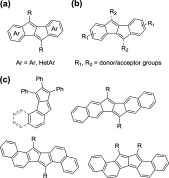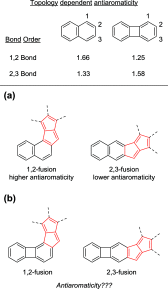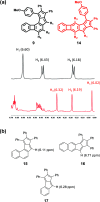Structure-Property Relationships in Unsymmetric Bis(antiaromatics): Who Wins the Battle between Pentalene and Benzocyclobutadiene?†
- PMID: 32189503
- PMCID: PMC7311060
- DOI: 10.1021/acs.joc.9b03119
Structure-Property Relationships in Unsymmetric Bis(antiaromatics): Who Wins the Battle between Pentalene and Benzocyclobutadiene?†
Abstract
According to the currently accepted structure-property relationships, aceno-pentalenes with an angular shape (fused to the 1,2-bond of the acene) exhibit higher antiaromaticity than those with a linear shape (fused to the 2,3-bond of the acene). To explore and expand the current view, we designed and synthesized molecules where two isomeric, yet, different, 8π antiaromatic subunits, a benzocyclobutadiene (BCB) and a pentalene, are combined into, respectively, an angular and a linear topology via an unsaturated six-membered ring. The antiaromatic character of the molecules is supported experimentally by 1H NMR, UV-vis, and cyclic voltammetry measurements and X-ray crystallography. The experimental results are further confirmed by theoretical studies including the calculation of several aromaticity indices (NICS, ACID, HOMA, FLU, MCI). In the case of the angular molecule, double bond-localization within the connecting six-membered ring resulted in reduced antiaromaticity of both the BCB and pentalene subunits, while the linear structure provided a competitive situation for the two unequal [4n]π subunits. We found that in the latter case the BCB unit alleviated its unfavorable antiaromaticity more efficiently, leaving the pentalene with strong antiaromaticity. Thus, a reversed structure-antiaromaticity relationship when compared to aceno-pentalenes was achieved.
Conflict of interest statement
The authors declare no competing financial interest.
Figures











Similar articles
-
Unsymmetrical Thienopentalenes: Synthesis, Optoelectronic Properties, and (Anti)aromaticity Analysis.ACS Omega. 2022 Mar 3;7(10):8336-8349. doi: 10.1021/acsomega.1c05618. eCollection 2022 Mar 15. ACS Omega. 2022. PMID: 35309486 Free PMC article.
-
The Impact of Antiaromatic Subunits in [4n+2] π-Systems: Bispentalenes with [4n+2] π-Electron Perimeters and Antiaromatic Character.J Am Chem Soc. 2015 Jun 10;137(22):7178-88. doi: 10.1021/jacs.5b03074. Epub 2015 May 27. J Am Chem Soc. 2015. PMID: 25978774
-
Facile Synthesis of Polycyclic Pentalenes with Enhanced Hückel Antiaromaticity.Angew Chem Int Ed Engl. 2017 Mar 13;56(12):3270-3274. doi: 10.1002/anie.201611344. Epub 2017 Jan 9. Angew Chem Int Ed Engl. 2017. PMID: 28067436
-
Usefulness of the σ-Aromaticity and σ-Antiaromaticity Concepts for Clusters and Solid-State Compounds.Chemistry. 2018 Jan 9;24(2):292-305. doi: 10.1002/chem.201702035. Epub 2017 Oct 17. Chemistry. 2018. PMID: 28593736 Review.
-
The application of aromaticity and antiaromaticity to reaction mechanisms.Fundam Res. 2023 Apr 28;3(6):926-938. doi: 10.1016/j.fmre.2023.04.004. eCollection 2023 Nov. Fundam Res. 2023. PMID: 38933008 Free PMC article. Review.
Cited by
-
Unsymmetrical Thienopentalenes: Synthesis, Optoelectronic Properties, and (Anti)aromaticity Analysis.ACS Omega. 2022 Mar 3;7(10):8336-8349. doi: 10.1021/acsomega.1c05618. eCollection 2022 Mar 15. ACS Omega. 2022. PMID: 35309486 Free PMC article.
-
Effects of benzoheterocyclic annelation on the s-indacene core: a computational analysis.Chem Sci. 2024 Nov 18;16(2):575-583. doi: 10.1039/d4sc06812b. eCollection 2025 Jan 2. Chem Sci. 2024. PMID: 39568951 Free PMC article.
-
Indoloindolizines: The Complete Story of a Polycyclic Aromatic Scaffold from Theoretical Design to Organic Field-Effect Transistor Applications.J Am Chem Soc. 2025 Feb 19;147(7):5996-6005. doi: 10.1021/jacs.4c16189. Epub 2025 Jan 14. J Am Chem Soc. 2025. PMID: 39807566 Free PMC article.
-
Linear π-conjugated polycyclic compounds consisting of four-, five-, and six-membered rings: benzo[1'',2'':3,4;4'',5'':3',4']bis(cyclobuta[1,2-c]thiophene).RSC Adv. 2023 Feb 3;13(7):4578-4583. doi: 10.1039/d3ra00144j. eCollection 2023 Jan 31. RSC Adv. 2023. PMID: 36760295 Free PMC article.
-
Stable Monoareno-pentalenes with Two Olefinic Protons.Org Lett. 2023 Jan 13;25(1):42-46. doi: 10.1021/acs.orglett.2c03752. Epub 2022 Dec 28. Org Lett. 2023. PMID: 36576234 Free PMC article.
References
-
- Breslow R. Antiaromaticity. Acc. Chem. Res. 1973, 6, 393–398. 10.1021/ar50072a001. - DOI
-
- Minkin V. I.; Glukhovtsev M. N.; Simkin B. Y.. Aromaticity and Antiaromaticity; John Wiley and Sons: New York, 1994.
Publication types
LinkOut - more resources
Full Text Sources
Research Materials
Miscellaneous

